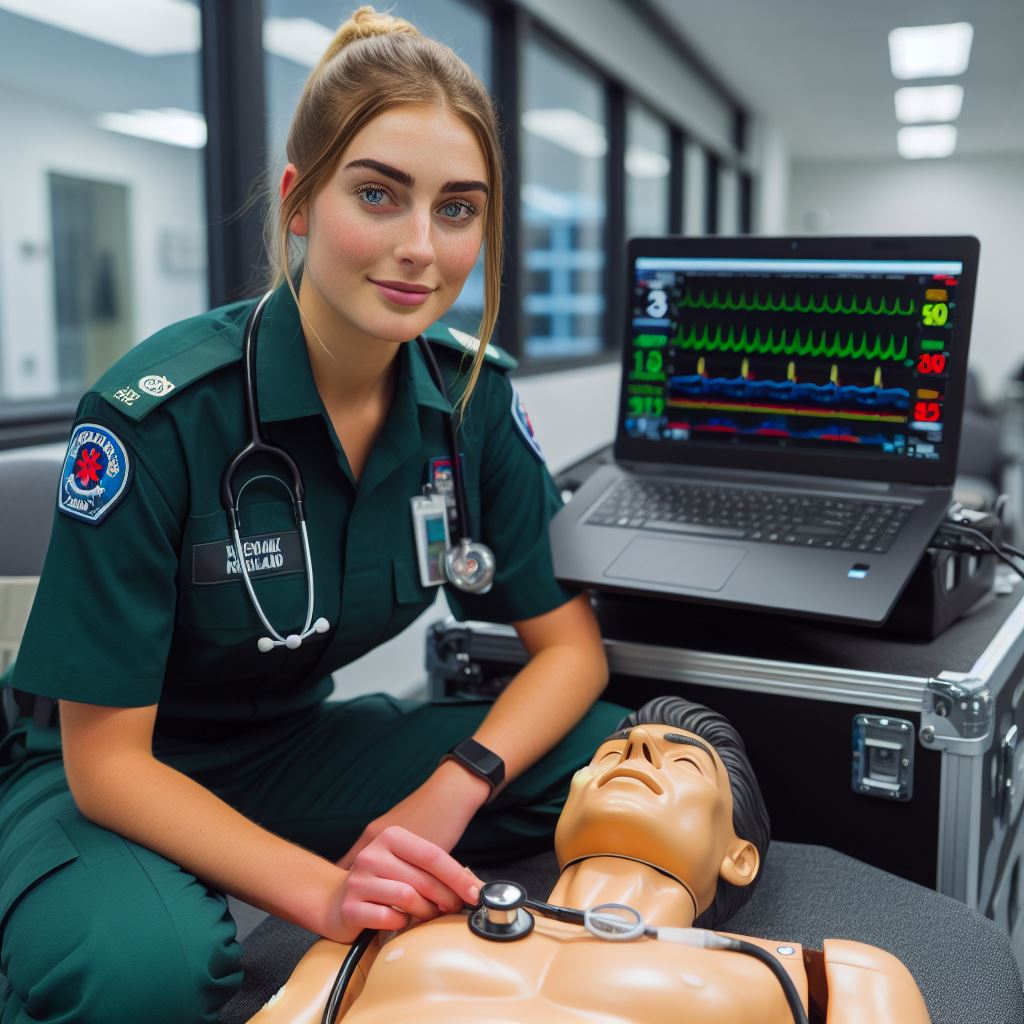Introduction
Paramedicine in New Zealand encompasses a multifaceted domain, intertwining pre-hospital care, emergency response, and medical transportation.
Within this dynamic field, paramedics serve as frontline responders, delivering critical medical interventions and stabilizing patients before they reach hospital facilities.
They operate in diverse environments, from urban centers to remote rural areas, often facing unique challenges and scenarios that demand quick thinking and adaptability.
Delving into the future of paramedicine holds immense importance and relevance in the context of New Zealand’s healthcare landscape.
As the population grows and ages, the demand for emergency medical services continues to escalate.
Discussing the future trajectory of paramedicine allows for proactive planning and strategizing to ensure that the profession remains equipped to meet the evolving needs of communities.
Moreover, exploring advancements in technology, changes in healthcare policies, and innovative approaches to training and education are crucial for enhancing the effectiveness and efficiency of paramedic services.
Current State of Paramedicine in New Zealand
Overview of the profession and its role
- Paramedicine is a vital profession that provides emergency medical care in New Zealand.
- Paramedics are highly trained healthcare professionals who respond to medical emergencies.
- Their role includes assessing patients, providing life-saving interventions, and transporting patients to the hospital.
- Paramedics work both in pre-hospital settings and alongside other healthcare professionals in hospitals and clinics.
Licenses and certifications required
- To work as a paramedic in New Zealand, individuals must be registered with the New Zealand Paramedic Registration Board.
- They also need to hold a current Annual Practicing Certificate (APC) issued by the Paramedic Council of New Zealand.
- Obtaining these licenses and certifications ensures that paramedics meet the required standards of competency and professionalism.
Existing challenges and limitations in the field
- One of the significant challenges faced by paramedics in New Zealand is the high demand for their services.
- Paramedics often have to work under stressful conditions and long hours due to limited resources and increasing call volumes.
- Another limitation is the lack of recognition and understanding of the paramedic profession by the general public.
- Many people are unaware of the scope of practice and the level of skill paramedics possess.
- Furthermore, paramedics often face difficulties in accessing ongoing professional development opportunities.
- This can hinder their ability to stay up-to-date with the latest advancements in pre-hospital medical care.
- In rural areas, the challenges are even more pronounced due to the limited availability of healthcare facilities and resources.
- Paramedics working in these regions often have to travel long distances to reach patients and lack immediate backup support.
- Additionally, paramedics in New Zealand face the ongoing issue of exposure to occupational hazards such as violence and infectious diseases.
- It is crucial for the government and healthcare authorities to address these challenges and provide necessary support to paramedics.
Navigating Challenges: The Future of Paramedicine in New Zealand
In general, the current state of paramedicine in New Zealand highlights the indispensable role paramedics play in providing emergency medical care.
To ensure the quality of care, licenses and certifications are required.
However, paramedics face challenges related to high demand, limited resources, public perception, professional development, and difficulties in rural areas.
Addressing these challenges and offering support is essential for the future of paramedicine in New Zealand.
Read: NZ Doctors’ Salaries: Expectations vs. Reality
Technological Advancements and their Impact on Paramedicine
Emerging technologies and their potential benefits
- Nanotechnology: Miniature medical devices can be inserted into the body to monitor vital signs and administer medication.
- Artificial intelligence: AI systems can help make more accurate diagnoses and provide real-time recommendations for treatment.
- Virtual reality: VR technology can be used to enhance training programs for paramedics, allowing them to practice in realistic scenarios.
- Telehealth: Remote consultations and monitoring can be conducted through video calls, improving access to healthcare for remote areas.
Examples of technologies currently being used in paramedicine
- Mobile data terminals: Paramedics can access patient records and communicate with hospitals in real-time.
- Smartphone apps: Some apps provide step-by-step guidance for performing CPR or managing medical emergencies.
- Automated external defibrillators (AEDs): These devices deliver electric shocks to restore normal heart rhythms in cardiac arrest patients.
- Wireless vital sign monitors: Paramedics can wirelessly transmit vital sign data to hospitals for immediate assessment.
Potential changes and improvements in patient care and treatment
- Quicker response times: Advanced communication systems allow paramedics to receive information faster and reach patients more efficiently.
- Accurate diagnoses: AI systems can analyze vast amounts of data to assist in diagnosing complex conditions accurately.
- Personalized treatment plans: Technology enables paramedics to tailor treatment strategies to individual patient needs.
- Better communication and collaboration: Real-time information sharing enhances coordination between paramedics and hospitals.
- Enhanced monitoring: Continuous monitoring of patient vitals enables early detection of deteriorating conditions and faster intervention.
Transformative Technologies Shaping the Future of Paramedicine in New Zealand
The future of paramedicine in New Zealand is closely intertwined with technological advancements.
Emerging technologies like nanotechnology, artificial intelligence, virtual reality, and telehealth have the potential to revolutionize patient care and treatment.
Nanotechnology offers the possibility of inserting miniature medical devices inside the body to monitor vital signs and deliver targeted medications.
This technology could significantly improve the accuracy and effectiveness of paramedic interventions.
Artificial intelligence systems can assist paramedics in making more accurate diagnoses and recommending appropriate treatments.
By analyzing vast amounts of data, AI can provide real-time guidance and improve patient outcomes.
Advancing Paramedic Training and Care through Technology
Virtual reality technology can enhance training programs for paramedics.
By simulating realistic scenarios, paramedics can practice their skills and decision-making in a controlled environment, improving their readiness for real emergencies.
Telehealth enables remote consultations and monitoring, particularly beneficial for patients in remote areas with limited access to healthcare facilities.
Through video calls, paramedics can connect patients with healthcare professionals and receive guidance on patient care.
Paramedicine in New Zealand already benefits from various technologies currently in use.
Mobile data terminals allow paramedics to access important patient information and communicate in real-time with hospitals for better coordination.
Enhancing Emergency Response with Cutting-Edge Technology
Smartphone apps provide paramedics with step-by-step guidance for performing critical procedures like CPR.
These apps can be valuable resources in emergency situations, offering immediate assistance when needed.
Automated external defibrillators (AEDs) have become essential tools for paramedics.
These devices deliver electric shocks to restore normal heart rhythms in cardiac arrest patients, improving their chances of survival.
Wireless vital sign monitors enable paramedics to assess patients’ vital signs and transmit the data wirelessly to hospitals.
This facilitates faster assessment and allows for immediate medical interventions when necessary.
Revolutionizing Paramedicine: Harnessing Technology for Enhanced Patient Care
The potential changes and improvements facilitated by technological advancements in paramedicine are significant.
Advanced communication systems can lead to quicker response times, ensuring that patients receive prompt medical attention.
AI systems hold the promise of more accurate diagnoses. By analyzing patient data and comparing it with vast medical knowledge, AI can assist paramedics in diagnosing complex conditions correctly.
Personalized Career Consulting
Unlock your potential with expert career advice tailored to your goals. Get personalized guidance and actionable steps toward your dream career in New Zealand.
Get StartedWith the help of technology, paramedics can develop personalized treatment plans tailored to individual patient needs.
This individualized approach ensures that patients receive the most appropriate care for their specific health conditions.
Transforming Paramedicine in New Zealand: Leveraging Technology for Enhanced Patient Care
Real-time information sharing through technology enhances communication and collaboration between paramedics and hospitals.
This enables seamless coordination, ensuring that patients receive continuous care throughout their journey from the scene of an emergency to the hospital.
Continuous monitoring of patient vitals using advanced technology allows for early detection of deteriorating conditions.
Prompt intervention based on real-time data can prevent complications and improve patient outcomes.
Essentially, technological advancements have the potential to revolutionize paramedicine in New Zealand.
Emerging technologies and current technological applications offer numerous benefits, including improved patient care, faster response times, and more accurate diagnoses.
The integration of technology into paramedic practice will undoubtedly shape the future of healthcare in New Zealand.
Read: NZ’s Top Medical Facilities: Doctors’ Views
Workforce Changes and Training Programs
Analysis of the current paramedicine workforce and demographics
- The current paramedicine workforce in New Zealand is composed of highly skilled professionals.
- Paramedics come from diverse backgrounds, bringing a range of experience and expertise to the field.
- Demographic data shows that the majority of paramedics in New Zealand are aged between 25 to 45 years old.
- There is a gender imbalance within the paramedicine workforce, with a higher number of males compared to females.
Projected changes in the workforce
- With the aging population and increased demand for healthcare services, the paramedicine workforce is expected to grow.
- There will be a need for more paramedics to cater to the growing healthcare needs of the population.
- Advancements in technology and medical practices may also lead to changes in the roles and responsibilities of paramedics.
- Furthermore, the introduction of new telemedicine initiatives may require paramedics to adapt to new ways of providing healthcare.
Importance of continuous training and professional development
- Continuous training and professional development are essential for paramedics to maintain high standards of care.
- Paramedics must stay updated with the latest medical breakthroughs, treatment protocols, and emergency procedures.
- Training programs should focus on enhancing paramedics’ clinical skills, critical thinking abilities, and communication techniques.
- Regular training also helps paramedics adapt to evolving technologies and stay competent in delivering quality care.
- Continued professional development allows paramedics to stay abreast of changes in healthcare policies and regulations.
Overall, the future of paramedicine in New Zealand’s workforce is promising.
With projected growth and advancements in technology, the role of paramedics will continue to evolve.
However, it is crucial for paramedics to engage in continuous training and professional development to meet the changing needs of the healthcare system and deliver quality care to the population.
Read: Emergency Medicine in NZ: Inside Look

Collaboration with Other Healthcare Sectors
Importance of interprofessional collaboration in paramedicine
Interprofessional collaboration is crucial in paramedicine as it promotes better patient outcomes and enhanced care delivery.
Collaboration allows paramedics to work alongside other healthcare professionals, sharing their expertise and knowledge.
Through collaboration, paramedics can gain a wider perspective on patient care, leading to improved decision-making and treatment options.
The integration of different healthcare sectors fosters a team-based approach, ensuring seamless care transitions for patients.
Examples of successful collaborations with other healthcare professionals
Paramedics in New Zealand have successfully collaborated with emergency department physicians to provide more effective pre-hospital care.
Collaboration with nurses has also been instrumental in improving patient care, especially during critical situations.
Pharmacists have played a significant role in educating paramedics about medication management, leading to safe and accurate administration.
Transform Your Career with a Professional CV and Cover Letter
Stand out to employers with an ATS-optimized resume and tailored cover letter designed to match your dream role. Let us craft your job application materials for success!
Get StartedWorking in partnership with mental health professionals has allowed paramedics to better address the needs of patients experiencing mental health crises.
Potential future partnerships and benefits for patient care
Fostering collaborations with general practitioners can enhance continuity of care as paramedics can provide vital patient information upon handover.
Partnering with physiotherapists can lead to improved rehabilitation plans, ensuring patients receive the necessary follow-up care.
Engaging with social workers can help address social determinants of health, resulting in a holistic approach to patient care.
Collaborating with occupational therapists can aid in optimizing patient independence and functionality post-injury or illness.
Developing partnerships with community health organizations can facilitate better aftercare and support for patients in their own homes.
The benefits of these collaborations include improved patient outcomes, reduced healthcare costs, and increased efficiency in healthcare delivery.
Paramedics’ enhanced access to the expertise of other healthcare professionals allows for more accurate diagnoses and tailored treatment plans.
Involving multiple healthcare sectors also ensures a comprehensive and well-rounded approach to patient care, addressing all aspects of their health.
Furthermore, collaboration promotes mutual learning and professional growth, contributing to the advancement of paramedicine as a field.
In a nutshell, collaboration with other healthcare sectors is of utmost importance in the future of paramedicine in New Zealand.
By working together, healthcare professionals can provide better care, leading to improved patient outcomes and a more efficient healthcare system.
Women in Medicine: NZ Doctor Profiles
Government Policies and Regulation
Overview of current regulations and policies regarding paramedicine
- New Zealand currently has a well-established framework of regulations and policies governing paramedicine.
- The Health Practitioners Competence Assurance (HPCA) Act 2003 provides the legal basis for regulating paramedics in New Zealand.
- This Act establishes the Paramedic Council of New Zealand (PCNZ) as the regulatory body responsible for the registration and oversight of paramedics.
- Under the current regulations, paramedics must meet specific educational and professional competence requirements to obtain and maintain their registration.
- Paramedics are required to participate in ongoing professional development activities to ensure their skills and knowledge remain up to date.
- The current regulations also outline the scope of practice for paramedics, defining the types of medical procedures and interventions they can perform.
- Overall, the regulations and policies in place aim to ensure the safety and quality of paramedicine services in New Zealand.
- Paramedics play a vital role in the healthcare system, providing emergency medical care and transportation to those in need.
- Their work often involves making critical decisions and delivering immediate life-saving interventions.
Potential changes and reforms in the future
- As the healthcare landscape evolves, there is an ongoing need to review and update regulations and policies governing paramedicine.
- One potential area for change is the expansion of the scope of practice for paramedics to include advanced procedures.
- This could enable paramedics to administer certain medications or perform additional interventions, enhancing their capabilities in emergency situations.
- Another area of potential reform is the development of clear protocols and guidelines for the integration of paramedics into various healthcare settings.
- Paramedics have the potential to contribute significantly to the provision of community-based healthcare services beyond emergency response.
- By integrating paramedics into primary care teams or community clinics, the overall accessibility and effectiveness of healthcare can be improved.
- Furthermore, there is a growing recognition of the importance of mental health support in emergency medical care.
- Future reforms may focus on enhancing the training and support systems for paramedics to effectively address mental health crises.
Advocacy for improved recognition and support for paramedics
- Paramedics are often at the forefront of emergency medical care and play a crucial role in saving lives.
- Despite their critical contributions, paramedicine has historically faced challenges in terms of recognition and support.
- Advocacy efforts are needed to raise awareness about the importance of paramedicine and its impact on patient outcomes.
- Improved recognition can lead to increased funding and resources, enabling paramedics to deliver high-quality care.
- Additionally, advocating for better support systems, such as mental health services and peer support programs, is essential.
- Paramedics often face challenging and traumatic situations, and prioritizing their well-being is crucial for the sustainability of the profession.
- By advocating for improved recognition and support, it is possible to ensure the continued growth and success of paramedicine in New Zealand.
- Paramedics deserve recognition as valued healthcare professionals and the necessary support to thrive in their roles.
Conclusion
Recap of the future prospects for paramedicine in New Zealand
Despite the challenges, the future of paramedicine in New Zealand looks promising.
With advancements in technology, increased investment in healthcare, and a growing demand for emergency medical services, paramedics will play a crucial role in the healthcare system.
Boost Your Career with a Standout LinkedIn Profile
Attract recruiters and expand your network with a fully optimized LinkedIn profile tailored to highlight your strengths and professional goals. Let your profile open doors to new opportunities!
Get OptimizedCall to action for individuals interested in pursuing a career in paramedicine
If you are passionate about helping others, thrive in high-pressure situations, and enjoy constant learning and personal growth, a career in paramedicine may be the right path for you.
Take the first step today and explore the opportunities available.
Encouragement for continued discussions and research on the topic
The future of paramedicine in New Zealand is a topic that merits ongoing exploration and discussion.
As the healthcare landscape evolves, it is vital to stay informed and engage in research and dialogue that can shape the future of this important field.
Together, we can drive positive change and ensure the highest level of care for all New Zealanders.




